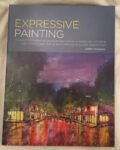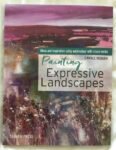My birthday's coming up and I have loads of new art instruction books to look…

Keep Painting, Gordon MacKenzie – Book Review
This one is 144 pages long and the first thing I notice is that it doesn’t feel like other art instruction hardbacks. The cover is warm and matty rather than cold and glossy. It doesn’t feel like fingermarks will show up on it but it does feel as if I won’t be able to wipe wine off if I spill some on it. And the pages inside are also matt rather than glossy. I probably prefer the look of glossy pages but I still find the change refreshing.
The idea of the book is to generate ideas for artists who are feeling that their work has started to get a bit samey and has stopped improving. It covers a number of areas and could claim to be targeting itself more at breadth than at depth, which is not necessarily a bad thing. Throughout the book, there are lots of examples of paintings that illustrate the ideas discussed. Sometimes the paintings are shown step by step, which I don’t always like, but in this case the steps were useful in illustrating points. I just don’t like it when the steps are there to be copied by the reader. Unless I’m reading a cookery book. Let’s talk briefly about the areas covered.
There’s a chapter on composition. There’s some interesting stuff on colour schemes and contrasts but I expect this will be covered in much more depth when I buy a book on colour. There’s a good point made about adding a bit of detail in the centre of interest of a painting – something that I’m too often guilty of neglecting. And there’s some stuff on guiding the eye around a painting that I still don’t get after reading both Roberts and MacKenzie. Oh well.
Then there’s a chapter on gradations and reversals. This is really good. There are lots of ideas about using gradations, with simplified diagrams of “models” for how to use them in composition. There’s also something on negative painting which will be covered in more detail by a Linda Kemp book that’s on my wishlist.
Then there are a couple of chapters on mingling colours, passages and atmospherics. These are right up my street and have given me lots of ideas. In particular, there’s some good stuff on how to include fog in landscapes, although the author may have included too many step by step illustrations of this – repetition isn’t the same as depth.
Then there’s a chapter on adding simplified “wee people” to paintings. It’s similar to what I’ve seen in Hazel Soan and Frank Clarke books but does include techniques that I’ve not seen in their books and is definitely useful.
There’s a chapter on working from photographs. I thought this was going to be like the Geoff Kersey book but not as deep. I was wrong. Whereas Geoff (being a realistic painter) talked a lot about what to leave out of paintings, Gordon talked about ideas like changing the colour scheme, tilting the photo, flipping photos, changing atmosphere/season,… Lots to think about.
And there was an introductory chapter that wasn’t much more than a load of encouraging words and a closing chapter on teaching other artists that felt out of place, but I can forgive those.
Overall, this was definitely a worthwhile purchase and is a book that I’ll continue to consult for years. I initially only gave it four palettes, citing the superfluous first and last chapters, too many step by step examples in places, the path into a painting not being brilliantly explained and the artist’s style being too different to mine, as niggles. But six years later in 2025, and wondering what to paint tomorrow, I can see so many ideas in this book that I want to try out. Palette inflation be damned. This one scores five.
You can find this book and more reviews of it at Amazon UK here.As an Amazon Associate, I earn commission from qualifying purchases but this costs absolutely nothing extra to you.








Leave a Reply